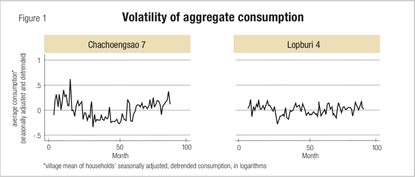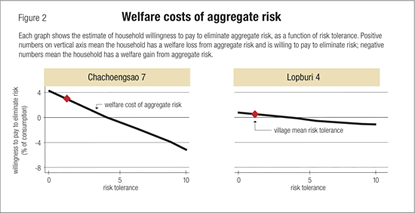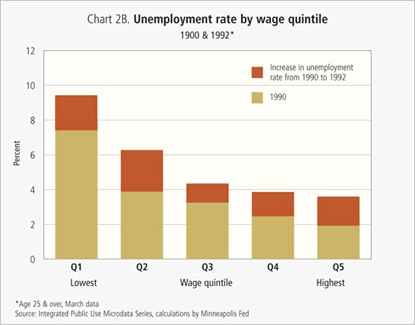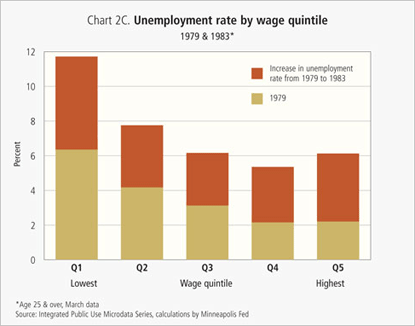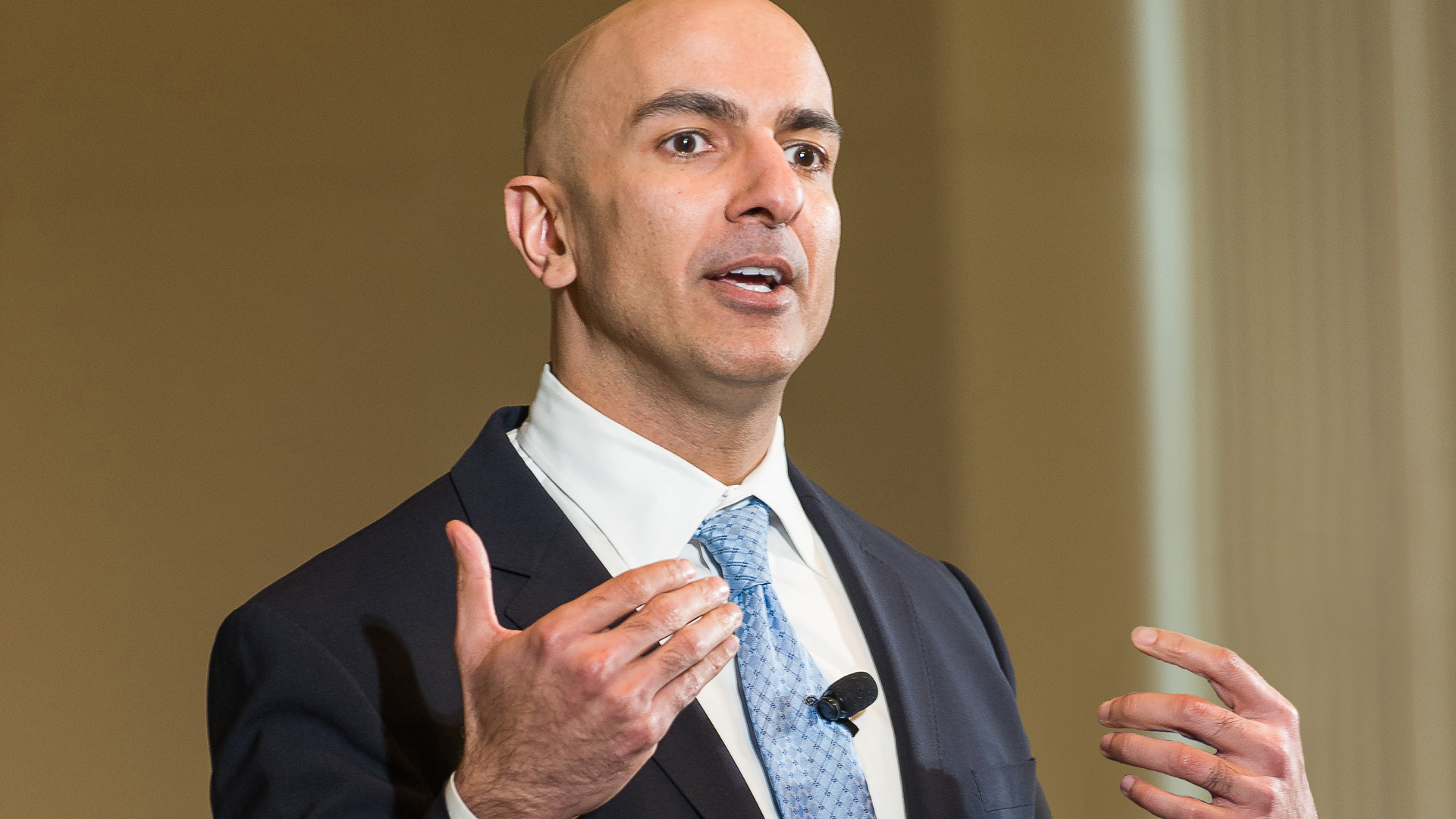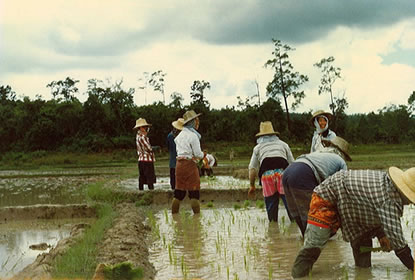
Photography by Robert M. Townsend, except where noted.
It may be a vestige of colonial history that leads people in industrialized nations to envision village life in developing countries as simple. Lacking the higher education, technology and financial sophistication of economically wealthy societies, goes the thinking, villagers in emerging nations live an uncomplicated, meager existence. Concepts like risk management, portfolio choice, insurance markets? Irrelevant, it would seem, to the life of a simple peasant.
In similar fashion, economists have long treated people in general as uncomplicated, undifferentiated units, neglecting the diversity of human existence that makes life interesting but math difficult. Researchers knew of this diversity, of course, but the absence of detailed data, combined with insufficient mathematical technique, long prevented them from plumbing the infinite variety of human traits and preferences. The “representative agent” has, until recently, been the stand-in for all of humanity.
Fortunately, both of these limited perspectives are changing. And in recent research with several colleagues, Sam Schulhofer-Wohl, senior staff economist at the Minneapolis Fed, uses more powerful techniques and a singular database to provide a nuanced look at both village life in the developing world and the remarkable variety of human preferences.
In “Heterogeneity and Risk Sharing in Village Economies” (Minneapolis Fed Working Paper 683, January 2011, with Pierre-André Chiappori, Krislert Samphantharak and Robert M. Townsend), Schulhofer-Wohl looks at differences in risk aversion among people (or more accurately, households) in four rural provinces in Thailand. They discover a rich complexity of village economics and a wide range of preferences regarding risk: Some households have an extreme aversion to it; others welcome it.
The research further suggests that before policymakers seek to address poverty by mitigating fluctuations that impose hardships on some villagers, they need to consider this variability. A number of households, the researchers indicate, might actually benefit from volatility in village income. A government program such as crop insurance could therefore have an adverse impact on some. “If aggregate risk were eliminated,” write the researchers, “some relatively risk-tolerant households would suffer welfare losses.”
This sounds counterintuitive: How can risk reduction be a bad thing? But the finding is wholly consistent with analysis of risk in other settings. And it suggests that viewing risk as an unmitigated evil is as superficial as thinking that villagers in the developing world lead simple lives.
Risky village life
“Rural villagers in Thailand face a great deal of risk,” noted Schulhofer-Wohl in a recent interview. “There may be a drought, and your rice fails. Or you’ve decided to farm shrimp in a pond, and the world price of shrimp can fluctuate a lot. So it’s a very risky life, and we wanted to think about how they deal with that.”
To an economist, that means (among other things) understanding risk preferences: Does an individual household want to avoid all possible fluctuation in its income, or is it fairly at ease with some variation from month to month? What is each household’s level of tolerance for—or aversion to—risk?
Until the late 1990s, most economic models assumed the same risk preference for everyone. “Researchers might have asked, ‘What is the risk aversion of a ‘representative’ American or a ‘representative’ person in Thailand?’” said Schulhofer-Wohl. But in the Thai study, the four economists moved beyond that simplistic view by measuring the full range of risk aversion in 16 villages and then seeking to understand how risk is managed. Might there be a role for government in smoothing out income fluctuations, or do villages fare well on their own?
Of course, assuming that all people have the same attitude toward risk was an unrealistic starting point, noted Schulhofer-Wohl. We all know daredevils and timid souls. But again, economists were limited by available data and technique. “It was a necessary simplification, both to do the math and because of the data we had,” he said. “Actually, the first paper that was really able to look at heterogeneity in risk aversion in a large-scale survey wasn’t published until 1997. Before that, there really wasn’t much.”
Now more data are available, and economists have developed better mathematical techniques that enable them to analyze the wide range of variability among individuals in risk preferences and other characteristics. (See “We Beg to Differ,” The Region, June 2009.)
“So, yes, it was obvious that there are big differences among people, and now economists are able to quantify those differences and see whether they matter in an economic sense,” explained Schulhofer-Wohl. “In this paper, our main goal was just to measure the differences in risk aversion, to take all the people in this data set and try to tag them with ‘OK, this person has this risk aversion, and this other person has this risk aversion.’”
A deep database
To do so, the researchers tapped a rich vein of data. Since August 1998, the Thai Family Research Project organized by Townsend, then at the University of Chicago, now at MIT, has gathered monthly data from families in 16 villages in four Thai provinces (see map). Buriram and Sisaket provinces, located near the border with Cambodia, are very rural. Chachoengsao and Lopburi are semi-urban provinces in the more-developed central region of Thailand, near Bangkok.
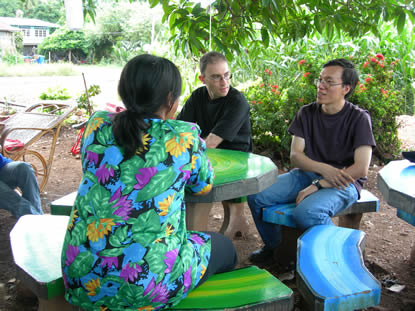
Sam Schulhofer-Wohl (center) in Thailand, with Anan Pawasutipaisit,
now at Thammasat University, and a Thai farmer (left)
The survey started with a complete census for every village and then randomly selected about 45 households from each to serve as survey respondents. Every month, households provide information about demographics that allows researchers to understand kinship networks, and then about a range of economic variables: household assets, monthly income, expenditure on food and nonfood items, as well as changes in the household’s makeup: deaths, births, marriages and the like. Identifying kinship networks was a critical part of the risk preference research because researchers could then study their role in helping households deal with financial fluctuations.
“It’s a pretty astonishing survey,” noted Schulhofer-Wohl. “The questionnaire is a really thick binder, and they just collect enormous amounts of information on a monthly basis.” It doesn’t simply ask how much money households spend, but what specifically they buy, grow, consume and save. “This survey is detailed enough that we can get those things right.”
As the survey’s founder, Townsend has close working involvement with the data and annually visits many villages. Chiappori, of Columbia University, and Samphantharak at the University of California, San Diego, have also been engaged in the study for several years. Schulhofer-Wohl, whose doctoral dissertation was advised by Townsend, visited Thailand in 2005 to develop a better understanding of actual conditions.
“At one point in grad school, I went to all 16 of the villages,” he recalled. “I thought, ‘If I’m working with these data, I should see what life is actually like there.’ In the northeast, most people are rice farmers. In Lopburi, nearer Bangkok, you would think you’ve landed in a very hot version of Wisconsin or southern Minnesota. It’s hilly. There’s a lot of corn being grown. And there are dairy farmers. The economy is a lot like it would have been in the Upper Midwest about 80 or 90 years ago. But then, of course, they’re also growing sugar cane.”
Volatile lives
While these villagers are far from rich by U.S. standards, few endure the extreme poverty seen in many nations. Monthly per capita consumption is about 1,300 Thai baht, the equivalent of about $3.50 per day per person. “That’s not very much in the U.S. It’s coffee at Starbucks,” noted Schulhofer-Wohl. “But relative to many developing countries, it’s a lot. A huge fraction of the world’s population lives on less than a dollar a day.”
And while there’s growth (albeit slow) in per capita consumption and a fairly high return on assets, aggregate consumption in many villages is volatile. Figure 1 depicts the range of volatility experienced in two of the 16 villages, (Chachoengsao 7 and Lopburi 4). The Chachoengsao village shows significant volatility, while Lopburi experienced a lesser range of highs and lows. (Similar volatility ranges are seen in the other 14 villages.)
Gauging attitudes
To understand how villagers feel about the risk implied by such volatility and to see how they cope with it, the researchers use two distinct techniques: risk sharing and portfolio choice.
The risk-sharing method is their primary tool. It’s based on the idea that people can guard themselves (if insurance providers exist) against individual risk but not against widespread risk: You can buy a fan, but you can’t change the weather.
So to understand how much people want to avoid risk (that is, have high risk aversion), you should see if their individual consumption is closely correlated with their community’s average consumption. If someone buys fans when it’s warm and sweaters when it’s cold, you know that person doesn’t enjoy temperature variation. But folks differ: Some like it hot.
People who are highly risk averse will try to cushion themselves against economic fluctuations, and so if good insurance networks exist, they’ll buy insurance that will prevent their consumption from fluctuating. Since their consumption levels won’t vary as much as the community’s, researchers can pinpoint the risk averse by seeing whose consumption isn’t tightly correlated with overall consumption levels.
By contrast, people who are more tolerant of risk will be willing to endure fluctuations in their consumption, so they can be identified as those whose consumption level, in the words of the researchers, “strongly co-moves with the aggregate.”
Risk sharing in the village
“This risk-sharing method of measuring risk aversion is a little surprising,” acknowledged Schulhofer-Wohl. “It’s not something that people usually think about. But it’s pretty apparent in village life. Suppose there’s a drought, and the rice crop doesn’t do well in Thailand. There’s less rice to go around, and someone will have to eat less. Who will that be?”
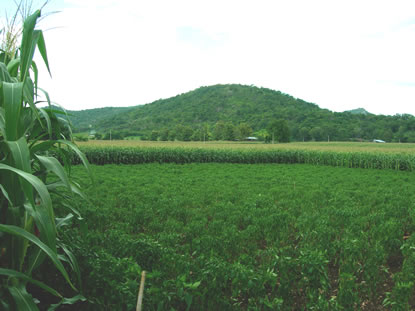
If everyone simply relies on their own crop, then a family’s consumption level depends strictly on their individual circumstance; if their crop failed, they’ll go hungry. “But one thing we’ve learned from an enormous literature on this point is that people really do share a lot of risk with their neighbors, especially in developing countries,” said Schulhofer-Wohl. “So if my crop fails and yours doesn’t, it’s quite likely that you’re going to share your rice with me, and vice versa.”
If drought hits the entire village, everyone will have a poor yield. “That’s an aggregate shock. Bad times. And it turns out that the person who is less risk averse is the one whose consumption will drop, because they don’t mind so much.” Of all the people in the village, their consumption will go down when there’s a drought and go up a lot in a very good year. “Those who are more risk averse will have very stable consumption,” said Schulhofer-Wohl. “They won’t suffer as much in a drought, nor benefit so much in good years.”
On reflection, the risk-sharing technique seems almost obvious. But to use it to identify levels of risk aversion, the economists need evidence that villagers actually do insure one another. Is each household an island, or do households truly share good and bad times? Only then can the researchers pinpoint risk preferences by looking at consumption correlation. “First,” said Schulhofer-Wohl, “we had to prove that villagers are sharing risk very well.”
Community saving
How? By looking at consumption shocks at both the individual household level and communitywide (or, in the jargon of economics, idiosyncratic and aggregate). If a family’s cow dies, does their consumption suffer? Efficient risk sharing (or full insurance) means that such idiosyncratic misfortunes won’t take a huge toll on the family because the blow will be softened by the community’s resources.
Of course, the community can’t escape broader misfortune: an epidemic that kills all the cows or makes everyone sick. “Their consumption will be affected by aggregate shocks,” explained Schulhofer-Wohl. “It has to be. There’s less to go around. But they’ll be insured against idiosyncratic shocks: When a bad thing happens to a household, their neighbors—or more accurately, relatives—will bail them out.”
The economists test the impact of idiosyncratic shocks on individual consumption by measuring correlations between the two. If the correlation is strong, full insurance doesn’t exist. But if there’s little relationship between shocks to household income and household consumption, it suggests that risks are well shared in the community as a whole. If that’s true, then the risk-sharing technique can be used to identify risk preferences for individual households.
A second tool: Portfolio choice
But the economists don’t rely on just one technique to gauge risk preference. They also use the portfolio-choice method, a tool that’s a bit more intuitive: An individual’s portfolio should reflect his or her attitude toward financial risk. So, if a family gambles, they’re probably quite tolerant toward financial risk; if they hide their savings under the mattress, they’re risk averse. More realistically, those who invest in high-tech stocks are more risk tolerant than those who deposit their savings in a government-insured bank account. Therefore, examining a household’s portfolio should give a good sense of their risk preferences.
“The families in our Thai villages engage in a variety of economic activities,” noted Schulhofer-Wohl. “Some farm rice. Others have a shrimp pond. Some may have a small shop. And we have very detailed data on the profits they get from these activities, so we can see which are basically very safe for them and which are very risky.”
The households who are engaged in riskier ventures must be less risk averse. So, by looking at returns on the households’ capital assets and measures of volatility in their consumption growth, the economists can identify households with lower asset returns, and little consumption volatility, as more risk averse, and vice versa.
Why two methods?
The economists hedge their research bet by using the portfolio-choice technique to verify (or refute) their risk-sharing method. If the two techniques produce similar findings, it suggests that the findings are valid.
But why go to the trouble of working through two difficult exercises if one might do? In a word, noise. “For each household, we have 84 months of data, or 84 data points,” explained Schulhofer-Wohl. “But they’re very noisy in the sense that if you ask people how much money they spent on different things, they make mistakes—none of us remembers perfectly.” Statistically, 84 simply isn’t a big sample; a few mistakes—noise—can distort the true story. “So we’re not going to get a very sharp estimate of one household’s risk preferences by looking just at those 84 data points.”
In a sense, the economists buy some insurance by using one technique to gauge the accuracy of the other. “The portfolio-choice method uses completely different data—looking at returns from activities households are involved in,” explained Schulhofer-Wohl. If the results jibe, it’s more likely that they’re accurate, not random, estimates.
As the working paper puts it: “Because the two methods differ, each serves as a check on the other; if the two methods give similar results, we can have more confidence that our estimates accurately reflect households’ actual preferences.”
And there’s another advantage: The portfolio-choice method allows the economists to compare risk aversion across villages, while the risk-sharing method can look only at household risk preferences within each village.
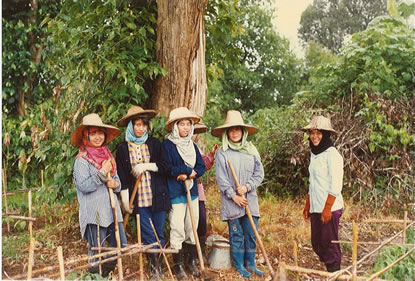
Generating results
Having established their research strategy and methods, the economists then pulled together the relevant data and generated results for each critical question:
- Do villagers share risks—that is, do they bail one another out in times of need?
- If so, do their attitudes about risk vary widely, or are they all roughly the same?
- What do these findings say about the costs and benefits of potential government policy to smooth out economic volatility in villages?
So, again, the first step was to establish whether or not the villages exhibited full insurance, or efficient risk sharing. In a famous 1994 study, Townsend examined data from three poor, high-risk villages in southern India and found—in results quite surprising at the time—that villagers did indeed share a great deal of risk: “Household consumptions comove with village average consumption,” he wrote, “[and] are not much influenced by contemporaneous income, sickness, unemployment or other idiosyncratic shocks.”
Do villagers in Thailand do the same? Yes. “We found that they do share risk very well,” said Schulhofer-Wohl. Indeed, says the working paper, “For households who have kin living in the village, we find evidence of nearly complete risk sharing.” In only two of the 16 villages is there any indication that full insurance doesn’t exist, and even in those two, unexpected income fluctuations for an individual household appear to have little impact on their consumption. “A 1 percent increase in income is associated with only a 0.013 percent increase in consumption.”
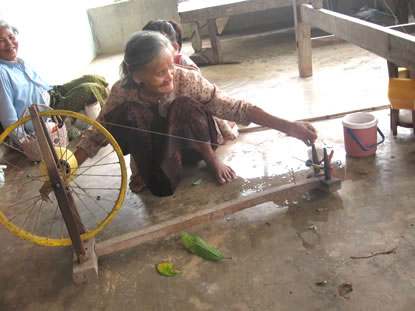
Photograph by Cynthia Kinnan
The importance of family
But there’s a revealing qualifier to this finding: It’s valid only for households who have kin living in the village. The economists’ statistical tests “do reject full insurance” among households without relatives living in the same village. The kinship networks—carefully documented by the database—apparently play a critical role in ensuring that those who need help get it.
“We think the mechanism must have something to do with the relatives,” said Schulhofer-Wohl. Many villagers themselves seemed surprised by this idea when he asked them about it, he noted. “Their perception was that they were totally on their own” even when they were surrounded by relatives. (These findings on the financial importance of kinship networks echo those found in two other recent Townsend studies.)
The current study doesn’t focus on the mechanisms themselves, but Schulhofer-Wohl suggested that village risk sharing may happen in ways not usually thought of as insurance per se. “For instance, I borrow some money from you, and I’m supposed to repay you. But then bad times hit, and we delay the repayment for a year or two. That would be insurance, but if I asked you, ‘Did you insure me against bad times?’ it wouldn’t come to mind.” Premiums don’t exchange hands, he noted, “but there’s a sense in which if I’m going to bail you out in bad times, you need to compensate me in good times,” perhaps by paying back a bit more than you borrowed.
Heterogeneous risk preferences?
Having found strong evidence of solid insurance mechanisms, the economists are able to use the risk-sharing method of gauging diversity in attitudes toward risk. (They confine their examination to households with village kin, since the risk-sharing method won’t work for those who have no nearby relatives and therefore lack full insurance.)
The econometrics are complex—“just-identified moment conditions,” “sign normalization”—but the idea is fairly evident. If households share risk well (as has been established), then a household whose consumption moves more than other households’ consumption when a communitywide shock occurs must be one that is less averse to risk: It absorbs a portion of the village shock by smoothing consumption for households that are more risk averse.
“In consequence,” write the economists, “we can identify more or less risk-averse households by looking at the pairwise correlations of their consumption.” If nearly everyone’s consumption is closely correlated with aggregate village shocks, risk preferences are almost identical, but they find quite the opposite.
They begin by looking at each village separately and find statistically significant evidence of varying risk preferences in about half of the 16 villages. When they pool the data from all the villages, their test becomes more powerful (a bigger sample improves statistical power), and they “strongly reject the null hypothesis that preferences are identical within each village.”
That’s an econometrician’s way of saying that the evidence suggests that attitudes toward risk do differ among households. “Statistically, you never prove that something is true,” explained Schulhofer-Wohl. “You just fail to prove that it’s false.” So by statistically rejecting the notion that preferences are identical (the “null hypothesis”), the test indicates that heterogeneity exists.
Check, please
They then use their second method: portfolio choice—the idea that households that invest their resources in riskier ventures are more risk tolerant. With this technique, the data show that average risk aversion differs quite a bit from village to village. Some villages have four times the aversion toward risk of others. Pooled together, the data suggest strongly that risk aversion differs a great deal by household.
As might be expected, the same is found for risk tolerance—the inverse of aversion. At the individual village level, the economists find strong evidence of diversity in risk tolerance; the statistical evidence isn’t as solid for heterogeneity in risk aversion. Nonetheless, the results from this second method generally suggest that Thai households with local kin vary in their levels of risk aversion.
This is substantiated by comparing the results from the two methods—the check to verify that the results are more than noise-generated randomness. Estimates of heterogeneity in risk preferences, they find, “are positively correlated in most villages.”
Still, the proof isn’t as solid as they’d hoped for. “We did not find very strong evidence,” observed Schulhofer-Wohl. “The correlation was statistically significant in less than half of the villages. But the data are noisy, so we were lucky to find anything. Obviously, we haven’t nailed it. It would have been nice if things had been more significant than they were. But we found some correlation, so that gave us some confidence that we were doing more than generating random numbers.”
They also find something rather unexpected: Neither measure of risk tolerance is correlated with household demographics or wealth. It might seem intuitively true that, say, the rich would be less averse than the poor to taking financial chances.
This result “surprised us,” noted Schulhofer-Wohl, “but it turns out to be consistent with what researchers have found in other data sets. It just seems that people are different from each other in a lot of ways, regardless of demographics. It’s been called ‘massive unexplained heterogeneity.’”
It’s also consistent with the notion that surprisingly sophisticated financial markets exist in Thai villages, allowing people of all sorts to hedge or speculate as suits their predilections and circumstances. Such markets “lead to a complete separation between consumption and production,” write the economists, “so there is no reason why risk preferences in themselves should affect how much wealth a household accumulates.”
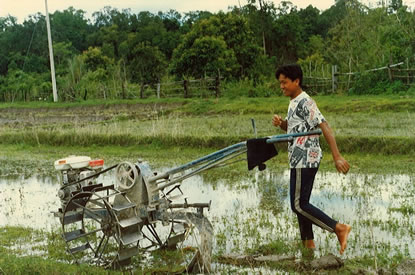
Policy to smooth turbulence
While this research is profoundly interesting to scholars, it’s also highly relevant to policymakers. Government programs have long sought to smooth out economic cycles, particularly to soften the hardships of recessions or, for farmers, crop failures. But doing so isn’t necessarily a good idea—some households may actually benefit from economic volatility, and their gains could conceivably outweigh the costs imposed on other households by economic fluctuation.
“This is an old question in both developed countries and developing countries,” noted Schulhofer-Wohl. “Economies go up and down. In the U.S., we have business cycles. In developing countries, there are fluctuations because of weather or commodity prices or other events. Would it be good to use economic policies to stabilize those fluctuations?”
Central banks like the Fed are often the focus of such debate: Can monetary policy be set to smooth out business cycles? Shocks are different in the developing world, and other policies might be used to address them.
“But there’s also the question of whether there would be any benefit to doing that,” said Schulhofer-Wohl. “Maybe people don’t mind those fluctuations so much.” Robert Lucas produced seminal research in 1987 suggesting that the benefits of smoothing business cycles in the United States are not very substantial, assuming reasonable levels of risk aversion.
That finding didn’t sit easily with all economists, who have since generated “an enormous literature” on the topic, said Schulhofer-Wohl. One direction this research has taken is to examine the implications of heterogeneous risk preferences. Lucas assumed identical preferences for all people, but what if some folks are very risk averse? Certainly they would benefit highly from policy to smooth business cycle fluctuation, right?
Winners and losers
But it turns out that in markets where risks are shared well—where those who want to insure themselves against shocks to their consumption can do so—the benefits of smoothing cycles are negligible, just as Lucas suggested.
In 2008, Schulhofer-Wohl published a study on the welfare cost of business cycles when insurance markets are complete—that is, when risk is well shared—and risk preferences differ. Using theory and U.S. data, he showed that “aggregate shocks generate small and bounded welfare costs even for consumers whose risk aversion approaches infinity” (emphasis in original).
Moreover, he wrote, because “the very risk-averse agents will buy insurance from less risk-averse agents [they] will not experience substantial consumption fluctuations; welfare losses are reduced for everyone.”
As long as there’s full insurance, explained Schulhofer-Wohl, “you just cannot find big welfare costs, because heterogeneity actually lets people start insuring one another.” Heterogeneity, he writes, “creates more opportunities for trade, thereby reducing the welfare cost of business cycles for everyone.”
For Thai villages, then, the economists pose the same question. There are big fluctuations in their income, far larger proportionately than in the United States. “You can imagine government policies to try to stabilize that,” said Schulhofer-Wohl. “So we ask, ‘What would be the benefits?’”
They discovered that, as you might expect, benefits vary widely from household to household. Risk-averse households would benefit from government insurance, but “other households are not very risk averse and they’d actually be made worse off by eliminating the shocks.”
Schulhofer-Wohl explained that risk-tolerant households may, in essence, run insurance companies. They don’t actually set up a formal insurance firm, but they’ll collect informal “premiums” of some sort for agreeing to help out their risk-averse relatives during turbulent times. If the government steps in and provides insurance for all, that’s great for the risk averse, but it puts the risk-tolerant households out of “business.” The premiums they once collected in exchange for smoothing consumption will dry up. “So there are people who could lose from eliminating aggregate shocks,” concluded Schulhofer-Wohl.
| Risk Tolerance and Welfare Cost of Aggregate Risk, by Villagea |
||
|---|---|---|
| Mean risk toleranceb | Willingness to pay to eliminate aggregate riskc |
|
Buriram |
||
2 |
2.97 | 0.6% |
10 |
4.02 | 0.4% |
13 |
7.61 | 0.2% |
14 |
3.55 | 0.7% |
Chachoengsao |
||
2 |
1.56 | 0.4% |
4 |
2.47 | 0.2% |
7 |
1.28 | 2.9% |
8 |
5.11 | 0.3% |
Lopburi |
||
1 |
1.36 | 0.2% |
3 |
1.33 | 0.9% |
4 |
1.29 | 0.4% |
6 |
1.29 | 0.4% |
Sisaket |
||
6 |
1.85 | 0.9% |
9 |
3.24 | 0.5% |
10 |
2.90 | 1.0% |
11 |
3.78 | 0.3% |
Note: a. Mean risk tolerance among households in each village, as estimated with the portfolio-choice method, and estimated willingness to pay to eliminate aggregate risk for a household with the mean risk tolerance. b. Bias-corrected estimate, based only on households with positive c. Reported as a percentage of mean consumption. |
||
Wide-ranging costs and preferences
The economists’ data show clearly the wide range of welfare costs from village to village. The accompanying table provides estimates for “willingness to pay to eliminate aggregate risk”—another way of saying the cost of communitywide economic fluctuation. The average household with the average risk tolerance in village 7 in Chachoengsao province, for example, would pay nearly 3 percent of their average consumption to eliminate risk; the comparable estimate in village 4 in Lopburi is just 0.4 percent.
The diversity of risk preferences within each village is also apparent from the data. Figure 2 shows the welfare costs of aggregate risk for four villages in relation to household risk tolerance. In all villages—including the 12 not depicted—households with lower risk tolerance are willing to pay more to eliminate risk, while those with high risk tolerance actually gain from villagewide risk.
In some villages, like Chachoengsao 7, the range is very wide. “Some very risk-averse households have welfare losses from aggregate risk equivalent to 4 percent of consumption,” write the economists, “but sufficiently risk-tolerant households could have welfare gains in excess of 6 percent of consumption.” A comparison of the consumption volatility graphs (Figure 1) with the welfare cost graphs hints at why this might be so. Chachoengsao 7 has experienced massive volatility. In Lopburi 4, where average willingness to pay to eliminate risk is much smaller, times have been relatively calm, and the welfare costs and gains are less extreme.
Theory versus reality
Schulhofer-Wohl is quick to point out that these results rest heavily on the assumption of full insurance. “Once you stick in shocks that people are not fully insured against, you get much bigger costs, for example, if you’re not insured against unemployment.” Since unemployment is prevalent during economic downturns, “some people are going to really suffer in recessions, and the welfare cost of business cycles will be large.”
So this is really a theoretical point. “I don’t want to say that I believe the welfare cost of business cycles in the U.S. is tiny,” he clarified. “But if we were to assume full insurance—which in the U.S., I think, is not true—it would be tiny. In Thailand, it’s much bigger because the aggregate fluctuations are much bigger.”
In any case, it’s clear from this work that policies to smooth aggregate risk are not unambiguously beneficial. And the economists have also demonstrated that village life is far less simple than many think—that indeed, research tools used to analyze risk on Wall Street’s complex financial markets are equally necessary for fathoming the intricate economics of rural Thailand.




